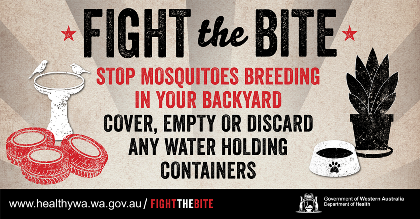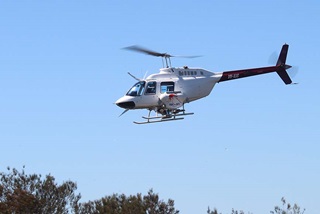Mosquitoes
City of South Perth Mosquito Management Plan
The City implements a Mosquito Management Plan to help reduce mosquito breeding from known wetland and saltmarsh breeding sites, particularly those along the Swan and Canning Rivers. While mosquitoes cannot be eliminated and they are an important part of ecosystems, the City aims to manage their numbers so that residents are afforded a reasonable outdoor amenity.
Mosquito breeding is primarily determined by environmental, meteorological factors such as rainfall, temperature and tidal activity. The City monitors mosquitoes by trapping and checking larval densities. Different mosquitoes breed in different areas, can travel varying distances and be more active at certain times.
A big part of the City’s mosquito management is via helicopter aerial treatment, which targets mosquito larvae in the water. The aerial larvicides used are granular Bacillus thuringiensis israelensis (Bti) or a combination of this with S-methoprene. They are target specific and have negligible impact on other aquatic and terrestrial species when used at label rates.
Mosquito management over a broader area
The City is part of a Contiguous Local Authority Group (CLAG) for the Swan and Canning Rivers. Along with the City of Perth, City of Canning, City of Melville and Department of Health WA, the group works together to best manage mosquitoes across the jurisdictions. Some mosquitoes can travel great distances, so it makes sense to work with our neighbours. The Department of Health WA provides expert advice and financial contribution to the CLAG. For further information, visit Contiguous Local Authorities Group (CLAG) Mosquito Management Program
Prevention is key
Mosquitoes will always be present, whether they come from wetlands, saltmarshes or household water sources. To avoid being bitten while outdoors:
- Apply mosquito repellent (follow label directions for safe use)
Wear light-coloured, loose-fitting long-sleeve shirts and pants
Limit outdoor activity from dusk into the night

Minimise mosquitoes around the home
- Remove stagnant water from items such as old tyres, swimming pools, fishponds, bird baths, pot plant saucers, canoes, drains, gutters, wheelbarrows and watering cans.
Maintain insect screens on your home and screen rainwater tank inlets and overflows.
Stock ponds and water features with fish such as pygmy perch, which feed on mosquito larvae.
Plant mosquito-deterrent plants.
Read more about preventing mosquitoes around the home here.
.tmb-med-fluid.jpg?Culture=en&sfvrsn=395afbd_1)
Fight the Bite
Fight the Bite is a State Government campaign that raises awareness about how to protect yourself from mosquito bites. For tips and resources to help you Fight the Bite at home or on holiday in Australia, visit the Fight the Bite website.

Chironomid midges: harmless mosquito lookalikes
Chironomid midges look very similar to mosquitoes but are harmless. They swarm near water at dusk and dawn and breed in the mud and organic matter of lakes and other water bodies, with numbers often rising after rain enriches the water with nutrients.
While they can be a nuisance in large numbers, they don’t bite or spread disease. Midges are faster flyers than mosquitoes and often form dense swarms near water. They’re attracted to light, so reducing outdoor lighting can help. During the day, they may be seen resting in groups on walls and other surfaces, unlike mosquitoes which typically prefer dark, cool, hidden places.
.tmb-med-fluid.jpg?Culture=en&sfvrsn=c795afbd_1)
Frequently Asked Questions


